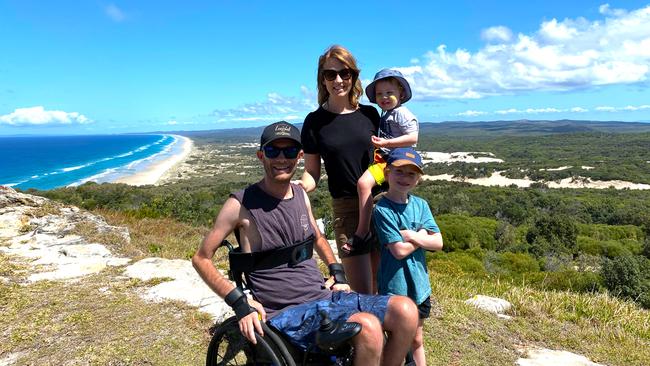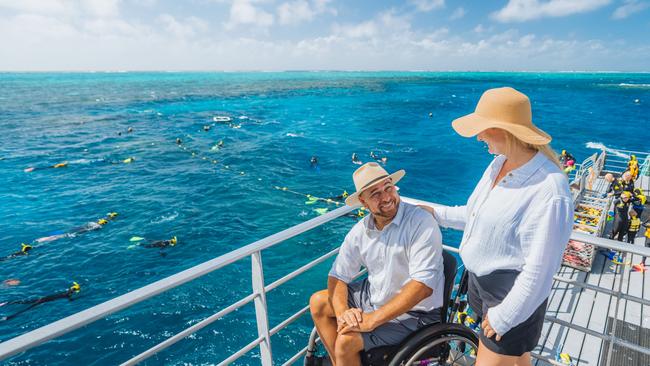Australia is lagging behind in accessible and inclusive tourism
Queensland’s Year of Accessible Tourism has been such a success, it should be expanded nationwide.
Lifestyle
Don't miss out on the headlines from Lifestyle. Followed categories will be added to My News.
In the early days after I injured my spinal cord while playing touch footy and was declared quadriplegic, I had so many questions running through my head. What’s my life going to look like now? Am I going to be isolated? Homebound? Institutionalised for the rest of my life? I saw my dreams of overseas travel and having a family slipping away. More than two decades later, I have a loving wife and three wonderful children, and I have been fortunate to travel all over the world. It’s a very different reality compared to what I initially feared. I now describe my accident as life changing, not life ending.
Before my accident, I was very active. I worked as an indoor rock-climbing instructor and was studying exercise science, with the plan of becoming a PE teacher. So when I go away, I don’t want to sit on the balcony of my accessible hotel room and watch my kids having fun. I want to participate, so I choose accessible and inclusive destinations that I can enjoy with my family.
I use access and inclusion as separate words, as they are two different concepts. Access means being physically accessible, whereas inclusion is about attitude. It can be daunting travelling to places like Venice, where there are more than 400 bridges to cross over 150 canals. But when I was there, all I had to do was roll to the end of the bridge and people would come from all over to help lift me over it. That’s an example of inclusivity.
Despite being a developed country, Australia has a long way to go in terms of developing accessible and inclusive tourism experiences. We probably sit mid-tier at best. Some of that is to do with infrastructure, but a lot is to do with attitude. In many places, especially in regional areas, the infrastructure is quite old. At the time of building, accessibility wasn’t at the forefront of thinking. A lot of infrastructure needs to be retrofitted or knocked down and completely rebuilt. In newer areas, buildings and facilities are being universally designed for everyone.
In many parts of Australia there’s still apathy in relation to accessibility and inclusivity. It’s getting better, but there’s an attitude of “why bother?” or “what’s in it for us?”. The answer is that almost one in five Australians lives with disability, and they spend $8 billion annually on tourism services. More people with disability are travelling thanks to the National Disability Insurance Scheme and advancements in technology. It’s not just financially damaging for an operator to ignore the market, but also damaging to their reputation.

Queensland is leading the way in accessible and inclusive tourism in this country. The state government declared 2023 the Year of Accessible Tourism, and it was so successful it was extended into 2024.
As part of the initiative, $12 million in funding was invested to help the state’s tourism industry better cater to visitors of all abilities. Operators in Tropical North Queensland in particular have been doing it well for a while. People in wheelchairs can go bungy jumping at AJ Hackett in Cairns, while Quicksilver Cruises has a water-powered lift offering the opportunity to go snorkelling on the Great Barrier Reef.
The new funding helped support projects like Access Vertigo, in which people in wheelchairs can dine at the top of the Brisbane Powerhouse before descending over the edge of the building via cables. It’s a unique experience that you previously wouldn’t have thought possible. Wheelchair users can now explore Maleny Botanic Gardens & Bird World on the Sunshine Coast on custom-designed buggies, while Queensland Music Trails has introduced initiatives like a tactile sensory silent disco tailored for neurodiverse and audio-sensitive audiences, an accessible viewing platform and Auslan interpreters on stage. It has created a legacy.

The organisation I work for, Sporting Wheelies, has also delivered awareness training to more than 200 people in the tourism industry. We also work with the team behind the Cérge companion app, which provides information about venues and alerts staff to service preferences in advance.
There’s no doubt Queensland has become the destination of choice Down Under for domestic and international travellers with disability. Other states are doing bits and pieces, but it’s not a whole ecosystem. That’s why I’d like to see the Year of Accessible Tourism expanded nationally in 2025.
Since the Year of Indigenous Tourism in 2020-21, such experiences have become embedded and we now have a strong offering across the country. I believe the same will happen with accessible and inclusive tourism. After a year or two it will become business as usual, which is the way it should be.
More Coverage
Originally published as Australia is lagging behind in accessible and inclusive tourism




